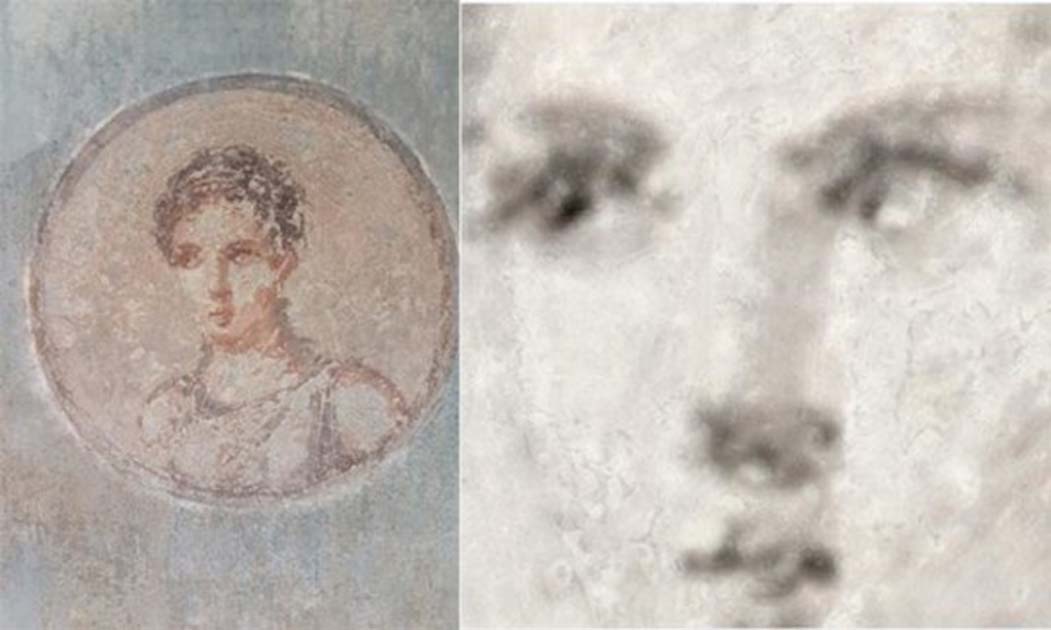X-ray Tech Reveals Remarkable Roman Artistry Hidden Under Ash of Vesuvius
Molten lava, volcanic ash, modern grime, salt, humidity. The ancient painting of a Roman woman has been through it all, and it looks like it. Scientists now report that a new type of high-resolution X-ray technology is helping them discover just how stunning the original portrait once was, element-by-element. The technique could help conservators more precisely restore this image, as well as other ancient artworks.
The researchers are presenting their work today at the 254th National Meeting & Exposition of the American Chemical Society (ACS).
"Science is allowing us to get closer to the people who lived in Herculaneum," says Eleonora Del Federico, Ph.D. "By unraveling the details of wall paintings that are no longer visible to the naked eye, we are in essence bringing these ancient people back to life. And learning more about the materials and techniques they used will help us to better preserve this artistry for future generations."
- Painting considered masterpiece of ancient Egypt may be an 1870s fake
- X-Ray Images Show Hidden Features in Painting of the Enigmatic John Dee
- Secrets in 2,000-Year-Old Scorched Scrolls of Herculaneum to be Revealed with New Tech
Tarnished History
Herculaneum was an ancient Roman resort town near modern-day Naples on the Italian coast. The city, along with nearby Pompeii, was destroyed during an eruption of Mount Vesuvius in 79 AD. For centuries, Herculaneum was buried under 66 feet of volcanic material, which helped preserve much of the artwork in the city. Ironically, it was only when Herculaneum was rediscovered and excavation began in the mid-19th century that many of the paintings, frescos and statues started to deteriorate. Humidity, temperature variations, salt and other atmospheric agents have done most of the damage. The portrait of the young woman, for instance, was only excavated about 70 years ago. Del Federico, who is at Pratt Institute's School of Liberal Arts and Sciences, speculates that when it was first uncovered, the image was probably stunning. But she says just a few decades of exposure to the elements has wrought incalculable damage to it.
The Science of Preservation
To help scientists involved with the Herculaneum Conservation Project better understand what they need to do to preserve this artwork, Del Federico and colleagues at the Pratt Institute and XGLab SRL sought to find out more about the wall paintings hidden beneath accumulating layers of crystalized salt and muck.

The ELIO device scanning the Roman portrait within the House of the Mosaic Atrium at Herculaneum. (Credit: Eleonora Del Federico)
In one of the first-of-its-kind field studies, the researchers used a recently developed portable macro X-ray fluorescence (macro XRF) instrument, ELIO by XGLab SRL, to scan and analyze a painting of a young woman in the ancient city. This new instrument allows scientists to noninvasively analyze a painting without having to move it or have the device come into contact with the artwork. ELIO can produce maps of the elements, such as iron, lead and copper, in the painting. Del Federico says these insights could help conservators choose cleaning solvents that are compatible with the elements in a painting and possibly allow much of its original magnificence to be restored.
- Experts discover traces of rare artificial pigment on Egyptian mummy portraits and panel paintings
- The Hidden Stories Behind Their Eyes: Unearthing the Secrets of Fayum Mummy Portraits
- Buried Face Down with a Bag of Coins: Mysterious 17th Century Grave Discovered in Switzerland

Images of the early Roman painting showing the various elements revealed by the macro X-ray fluorescence instrument. (Credit: Eleonora Del Federico)
The Analysis
After she used the method, Del Federico was surprised at how much detail it uncovered. The analysis revealed that the artist had sketched the young woman with an iron-based pigment and then highlighted around her eyes with a lead pigment. High levels of potassium in her cheeks suggested that green earth pigment was used as an underpainting to help create a "flesh" color. But the analysis also revealed much more.
"This young woman is gone forever, but our study has revealed in remarkable detail her humanity, her thoughtful expression and her beauty," Del Federico says.
Top image: An iron element map (right) made with new X-ray technology reveals the underlying craftsmanship hidden beneath a damaged portrait of a Roman woman (left).
Credit: Roberto Alberti, Ph.D.
The article, originally titled ‘Remarkable Artistry Hidden in Ancient Roman Painting Revealed,’ was originally published on Science Daily.
Source: American Chemical Society. "Remarkable artistry hidden in ancient Roman painting revealed." ScienceDaily. ScienceDaily, 21 August 2017. www.sciencedaily.com/releases/2017/08/170821085702.htm

















